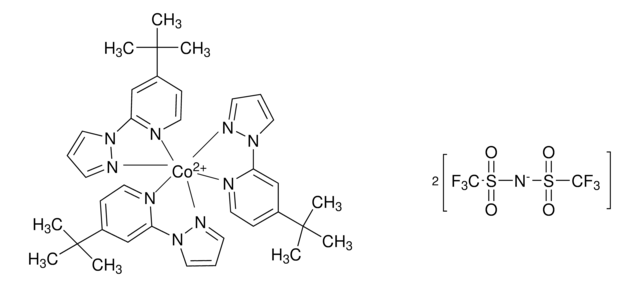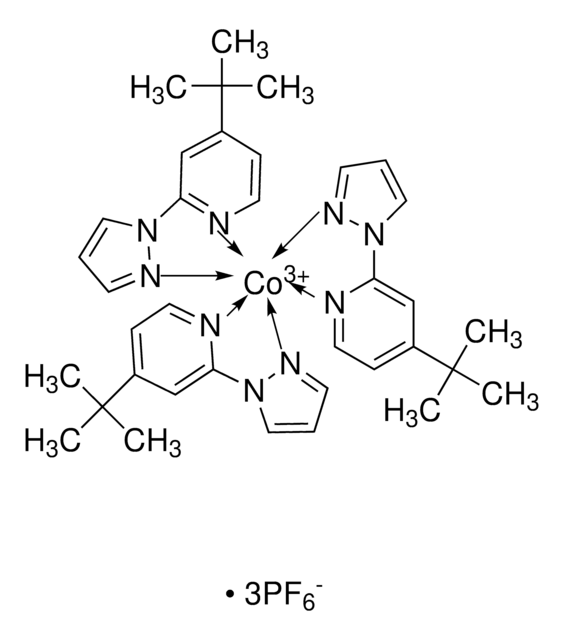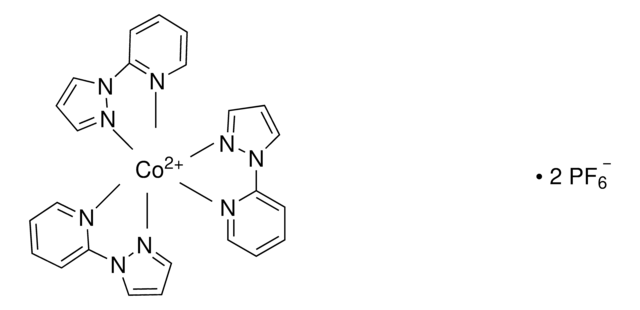推薦產品
化驗
98%
品質等級
形狀
powder
mp
194-199 °C
SMILES 字串
O=S([N-]S(=O)(C(F)(F)F)=O)(C(F)(F)F)=O.O=S([N-]S(=O)(C(F)(F)F)=O)(C(F)(F)F)=O.O=S([N-]S(=O)(C(F)(F)F)=O)(C(F)(F)F)=O.N1(C2=NC=CC=C2)N=CC=C1.C3(N4C=CC=N4)=CC=CC=N3.C5(N6C=CC=N6)=CC=CC=N5.[Co+3]
InChI
1S/3C8H7N3.3C2F6NO4S2.Co/c3*1-2-5-9-8(4-1)11-7-3-6-10-11;3*3-1(4,5)14(10,11)9-15(12,13)2(6,7)8;/h3*1-7H;;;;/q;;;3*-1;+3
InChI 密鑰
ILXRZLQXWLMDFQ-UHFFFAOYSA-N
一般說明
應用
推荐用于:
在液基电解液中:通常为0.15-0.2 M的Co(II)和约0.05 M 的Co(II)
在固态光伏电池中:添加至空穴传输材料系统中,重量百分比不超过10%。
法律資訊
訊號詞
Warning
危險聲明
危險分類
Eye Irrit. 2 - Skin Irrit. 2 - STOT SE 3
標靶器官
Respiratory system
儲存類別代碼
11 - Combustible Solids
水污染物質分類(WGK)
WGK 3
閃點(°F)
Not applicable
閃點(°C)
Not applicable
分析證明 (COA)
輸入產品批次/批號來搜索 分析證明 (COA)。在產品’s標籤上找到批次和批號,寫有 ‘Lot’或‘Batch’.。
文章
Next generation solar cells have the potential to achieve conversion efficiencies beyond the Shockley-Queisser (S-Q) limit while also significantly lowering production costs.
Dr. Perini and Professor Correa-Baena discuss the latest research and effort to obtain higher performance and stability of perovskite materials.
For several decades, the need for an environmentally sustainable and commercially viable source of energy has driven extensive research aimed at achieving high efficiency power generation systems that can be manufactured at low cost.
研究重點為可持續且具成本效益的發電系統,以滿足對環保能源日益增加的需求。
相關內容
Next generation solar cells have the potential to achieve conversion efficiencies beyond the Shockley-Queisser (S-Q) limit while also significantly lowering production costs.
我們的科學家團隊在所有研究領域都有豐富的經驗,包括生命科學、材料科學、化學合成、色譜、分析等.
聯絡技術服務






![[6,6]-苯基 C 61 丁酸甲酯 >99.5%](/deepweb/assets/sigmaaldrich/product/structures/359/221/d990c746-0960-4c69-bf76-fe09b193824d/640/d990c746-0960-4c69-bf76-fe09b193824d.png)
